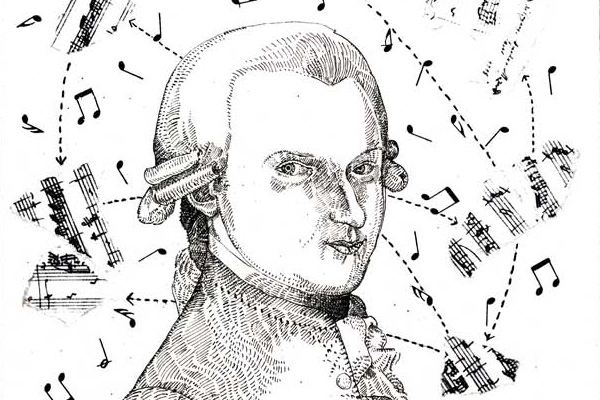
Sonic Geometry : The Language of Frequency and Form [Video]
Video uploaded by Alanna Luna on September 21, 2015
Mathematics and Music – The Secret Knowledge
Mathematics and music are two of the vehicle that assist us in our escape from time’s surface. Mathematics is available to a few; music is available to all. Mathematics allows us to assemble mental structures by which we comprehend entire sequence of logical implication at once. Music allows us to assemble temporal sequences into mental scaffolding that transcends the thinness of time in which we live. Through music, we are able to share four-dimensional structures we are otherwise only able to observe in slices, one moment at a time.
When computers began to multiply in the 1950s, artificial intelligence was believed to be just around the corner. Artificial music was surely almost as close at hand. Years later, artificial intelligence is still ahead. Electronics has enlarged our repertoire of instruments but has failed to produce anything more than a sympathetic resonance with the musical nature of our minds. Artificial music, so far, has the same relation to real music that animation has to life. Computers have perfect pitch, perfect timing, and perfect memory – achievements only the best musicians attain – yet something about music leaves them cold. The gap between the natural language of human beings and the higher-level languages and formalizations used by machines is slowly being bridged. But our music remains a foreign language to our machines.
How did music first evolve, and how might it develop further or evolve anew in different form? Neurophysiologist William Calvin has suggested that music is a by-product of the need to store complex sequences of motor instructions in serial buffers in the brain. “Movement command buffers, essential for planning ballistic movements (so fast that sensory feedback arrives too late to effect corrections), were surely under selection for throwing,” Calvin explained.” For organisms that need to be both large (meters of conduction distance) and fast, one often needs the neutral equivalent of an old-fashioned roll for a player-piano. We carefully plan during “get-set” to order to act without feedback. If those buffers are capable of sequencing other things when not needed for throwing-hammering-clubbing-kicking, the one might expect augmentation of such sequential abilities as stringing words together into sentences, or concepts into scenarios.” Calvin suggested that parallel command buffers – he used the analogy of trains being assembled on the parallel tracks of a freight yard – may have stored alternative sequences at the same time. Fitter or more attractive sequences would be selected to survive, reproduce and recombine.
Nature loves dual, or multiple, functions. Once motor-control sequences were stored in the same buffers as sequences of sound – a plausible scenario given the layout of mammalian brains – a cascade of developments was under way. The slow, evolutionary arms race between physically distinct individuals was accelerated by evolutionary processes acting within individual brains. To hit a target at even a modest distance, a thrown weapon must be released at exactly the right moment; the required submillisecond timing can be achieved only through parallel arrays of neurons that collectively smooth out the temporal jitter characteristic of a few neurons operating on their own. Precise relations between timing and frequency – the raw material of music – would be facilitated by the huge, parallel buffers of the expanding human brain, which, as we know but have yet to explain, tripled in volume over a short span of evolutionary time.
Larger brains allowed abstract four-dimensional processes to take root and grow. Individuals better able to plan, compare, rehearse, remember, and execute complex sequences of movements were better able to survive, and so these abilities were reinforced. But neither mind nor music, as far as we know, can be sparked in one brain alone. On one level, music may have evolved as a way to exercise and communicate these abilities; on another level, music may have evolved because these mental structures, able to reproduce themselves across time and distance, developed a life of their own.
To me, Calvin’s hypothesis strikes a chord. My grandfather George Dyson (1883 – 1964) was a professional musician who first secured fame and lasting fortune by his mastery of the art of throwing bomb. He wrote dozens of well-received works of music and three successful books, but none of them ever matched the sale of his instructions for hurling a kilogram of iron and high explosive thirty meters through the air. When war broke out in august 1914, my grandfather, unlike Olaf Stapledon or Lewis Richardson, had no second thoughts – he immediately signed up. He was commissioned as a lieutenant in the Ninety-ninth Infantry Brigade of the Royal Fusiliers, stationed at Tidworth on Salisbury Plain, and given the job of training infantry in the use of grenades before they went to France…
Dyson had been born with perfect pitch for music; he now did his best to cultivate perfect pitch n the throwing of grenades.
Excerpt from Darwin among the machines by George Dyson.
Links
- Need to sell your old gadget – The best place to sell smartphones and other devices online
- Everything About Apple’s Products – The complete guide to all Apple consumer electronic products, including technical specifications, identifiers and other valuable information.
- Everything About Microsoft’s Products – The complete guide to all Microsoft consumer electronic products, including technical specifications, identifiers and other valuable information.






Facebook
Twitter
RSS